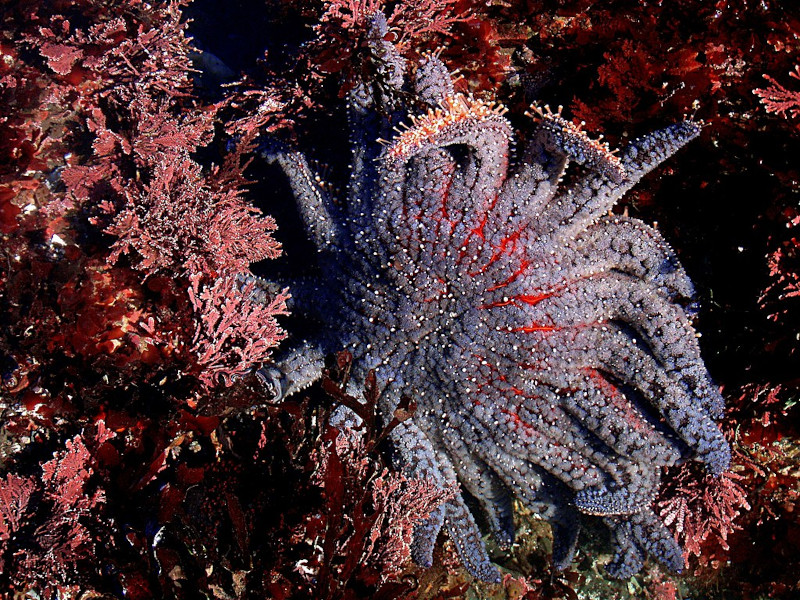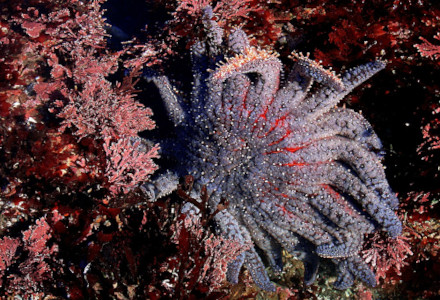
Sunflower Sea Star Facts
- This stunning marine creature most frequently goes by the descriptive, as well as informative, common name of the Sunflower Sea Star. That term’s easier to pronounce than its official name, thankfully. The technical name’s truly hard to pronounce.
- That’s because scientists know it best by the term of the Pycnopodia helianthoides. Regardless of which name one uses to refer to it though, it’s a marvel of evolution. It also stands out from its many related species due to the sheer size mature adults attain.
- The German-Russian naturalist Johann Friedrich von Brandt made the first formal recognition of it as a separae and distinct species. This noteworthy acknowledgement he accomplished in the year 1835. The reason for the name is a matter of speculation.
- Unfortunately, the population of this marvelous creature began to decline precipitiously around the year 2013. At that time, researchers discovered that much of its population suffered from a disease appropriately called Sea Star Wasting Disease.
- Evidence further indicates that the population loss for the species since that time approaches 90%. The IUCN, therefore, presently lists it as Critically Endangered. Sadly, though, the Sunflower Sea Star also remains vulnerable to the effects of climate change.
Related Articles
Sunflower Sea Star Physical Description
Many animals garner admiration or appreciation either for their size or appearance, but not the Sunflower Sea Star. That’s because it easily qualifies as one of the very small percentage that deserve notice for both qualities. The animal shows no sexual dimorphism, though.
For the moment, its ranking in terms of size remains a matter of small debate among researchers. As it currently stands, therefore, it’s either the largest or the second-largest of all known sea stars. Either ranking clearly earns it a full measure of notice.
Mature individuals of this amazing species attain an arm span of as much as 3.3 ft ( 1m)! Another species, though, the Midgardia xandaros, actually possesses a significantly greater arm span. It has a much smaller body and mass than the Sunflower Sea Star, however.
The appearance of this wonder of Nature also earns it much notice among those who encounter it. That’s because most adults display between 16 – 24 arms. Interestingly, however, infants have only 5 of these. The others appear as the creature ages.
The enormous echinoderm further tends to present bright, vivid colors. These also vary broadly between individuals, apparently independent of gender. These hues include shades of red, pink, orange, yellow, and brown. Some individuals even present shades of purple.
- Kingdom: Animalia
- Phylum: Echinodermata
- Class: Asteroidea
- Order: Forcipulatida
- Family: Asteriidae
- Genus: Pycnopodia
- Species: P. helianthoides
Sunflower Sea Star Distribution, Habitat, and Ecology
Although the population of the magnificent Sunflower Sea Star has greatly diminsihed, its overall range remains the same. It also evolved as endemic to a relatively wide swathe of the Pacific Ocean. More precisely, it appears in parts of the northeast Pacific Ocean.
Within that region of the globe, the animal appears, though now in small, scattered concentrations, in a specific territory. That native range extends from southern California, in the continental United States, in North America, to as far north as the state of Alaska.
The creature further displays very definite preferences in its choice of habitat. Virtually all observed individuals appear in either subtidal or intertidal regions. Its depth range typically extends from 435 – 1,428 ft (132.6 – 435.3 m). It also appears in regions of kelp or seaweed.
It’s also relatively quick, for a member of its Order. With its roughly 15,000 tube feet, it moves along the sea floor at speeds of roughly 3.3 ft (1 m) per minute. The carnivore prefers to dine mainly on sea urchins, but also consumes snails, sea cucumbers, and clams.
Its own predators include large fish, and even other sea stars of sufficient size, while it’s still young. The king crab also considers it a favorite meal. The animal even has the ability to break off one or more of its own arms, if attacked. This lets it escape complete consumption.
The remarkable Sunflower Sea Star, like others of its kind, reproduces through broadcast spawning. The young begin life as microscopic larvae, that float to the surface for 2 – 10 weeks. Following this period, they drop to the ocean floor, to live out the rest of their lives.
Species Sharing Its Range
Check out our other articles on 4 Scintillatingly Shaded Snakes, Orange Peel Doris, Skeleton Shrimp, Tufted Coquette, Chandipur Beach, Flying Duck Orchid, Jackson’s Chameleon

